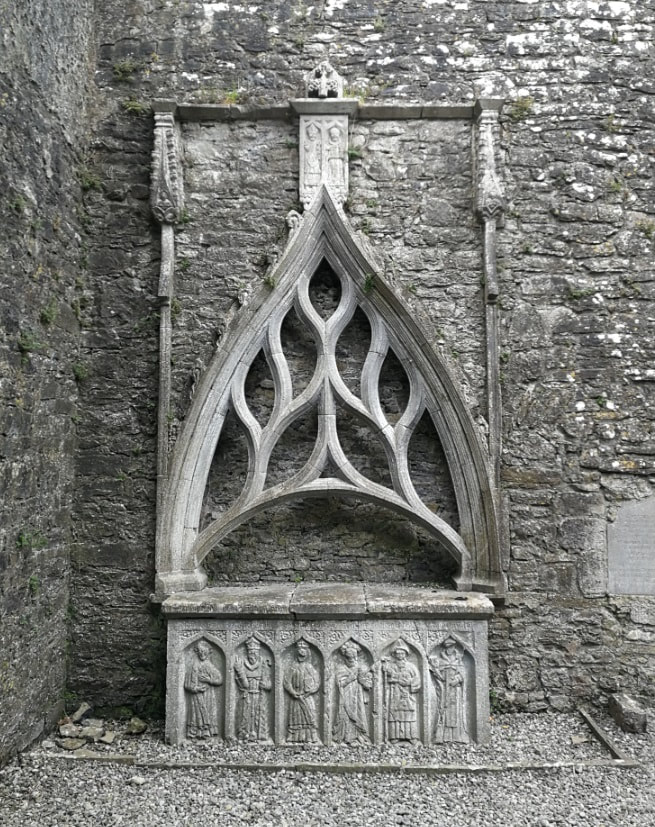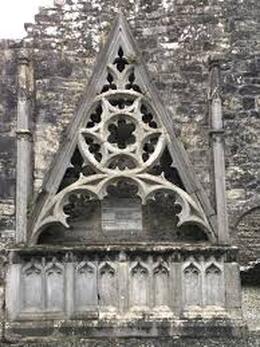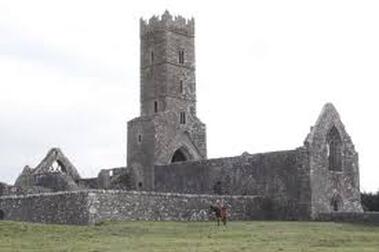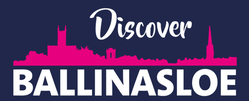|
By Barry Lally In 1351, William Buí O’Kelly, Lord of Hy Many, invited all the bards, brehons, artists, musicians and jesters from across Ireland to a Christmas Day feast at his castle on the banks of Lough Ree near Knockcroghery in County Roscommon. The month-long festivities gave rise to the expression “Fáilte Uí Cheallaigh”, still current in Irish, meaning hospitality of exceptional warmth and munificence. As he watched the departure of his guests from the temporary village he had constructed for their accommodation, O’Kelly was heard to ruefully remark: “Nach raibh mise an t-amadán mór?” (Wasn’t I the great fool?) Two years later he founded Kilconnell Conventual Franciscan Friary on the site of the 6th-century monastery of St. Connal. Besides the O’Kellys, the friary enjoyed the patronage and protection of other powerful Hy Many families such as the O’Donnellans, the O’Maddens and the Wards from the 14th to the 18th centuries, and the tombs of many of its patrons survive inside the ruins. In the 1460s, Malachy O’Kelly, a great-grandson of the founder, induced the friars to adopt the Observant reform involving a stricter interpretation of the rule of St. Francis. Between 1405 and 1534 all but one of the bishops of Clonfert were friars, and the bishop of Clonfert was one of the clerics most frequently called on the execute Bulls in favour of the friars. The presence of these friar-bishops must have played a crucial role in promoting the various forms of mendicant activity in the diocese. Though the friary had been officially dissolved in 1541 and granted to two English lessees, when Sir Richard Bingham, Governor of Connacht, garrisoned his troops there in 1580 he insisted that the buildings not be damaged or the friars molested. Similarly, in 1596, when the friary was occupied for nine months by the forces of Captain Stryck during a conflict with the O’Kellys, the friars were allowed to remain. Moreover, Kilconnell was one of only five Irish friaries still inhabited and in good repair in 1616. In 1351, William Buí O’Kelly, Lord of Hy Many, invited all the bards, brehons, artists, musicians and jesters from across Ireland to a Christmas Day feast at his castle on the banks of Lough Ree near Knockcroghery in County Roscommon. The month-long festivities gave rise to the expression “Fáilte Uí Cheallaigh”, still current in Irish, meaning hospitality of exceptional warmth and munificence. As he watched the departure of his guests from the temporary village he had constructed for their accommodation, O’Kelly was heard to ruefully remark: “Nach raibh mise an t-amadán mór?” (wasn’t I the great fool?) Two years later he founded Kilconnell Conventual Franciscan Friary on the site of the 6th-century monastery of St. Connal. Besides the O’Kellys, the friary enjoyed the patronage and protection of other powerful Hy Many families such as the O’Donnellans, the O’Maddens and the Wards from the 14th to the 18th centuries, and the tombs of many of its patrons survive inside the ruins. In the 1460s, Malachy O’Kelly, a great-grandson of the founder, induced the friars to adopt the Observant reform involving a stricter interpretation of the rule of St. Francis. Between 1405 and 1534 all but one of the bishops of Clonfert were friars, and the bishop of Clonfert was one of the clerics most frequently called on the execute Bulls in favour of the friars. The presence of these friar-bishops must have played a crucial role in promoting the various forms of mendicant activity in the diocese. Though the friary had been officially dissolved in 1541 and granted to two English lessees, when Sir Richard Bingham, Governor of Connacht, garrisoned his troops there in 1580 he insisted that the buildings not be damaged or the friars molested. Similarly, in 1596, when the friary was occupied for nine months by the forces of Captain Stryck during a conflict with the O’Kellys, the friars were allowed to remain. Moreover, Kilconnell was one of only five Irish friaries still inhabited and in good repair in 1616. With reference to the friary, in 1709 a traveller noted that “this abbey was in repair and inhabited in King James’s time, so that the woodwork, the wainscot and ordinary painting still remain.” He also recorded that the buildings were surrounded by a wall of skulls and bones, supposedly the unburied remains of the fallen at the Battle of Aughrim. The wall was about 4 feet high and 5 feet 4 inches thick. It doesn’t appear to have survived intact into the following century, for in 1827 Rev. Caesar Otway, a Church of Ireland clergyman, reported that nothing remained of it but “an immense stack of human bones.” Later in the century Baron Clonbrock used his influence to have the bones and skulls properly interred.
The most interesting of the friary’s altar-tombs is located near the west door of the nave and dates from the late 15th century. It has been described as having a flamboyant canopy with a front divided into six panels, “each one filled with a saintly figure, surmounted by its respective name, which are as follows: St. John the Evangelist, St. Louis of Toulouse, St. James, St. Catherine of Alexandria, the Virgin Mary, and St. Denis of Paris. The finial is divided into two panels, the one on the left is the figure of a bishop, and on the right is St. Francis.” Neither the owner of the tomb nor its occupant or occupants have been identified. Another tomb deserving of note is found in the north wall of the chancel and described as “altar-shaped with a rich canopy of quite different design (to that located at the west door), consisting of a rose tracery on a circular arch, the panels in front being plain.” Of mid-15th century construction, its original owner is unknown. At some stage it was appropriated by the O’Daly family. Kilconnell Friary is one the gems of Ballinasloe’s hinterland and well worth a visit, not only because it contains within its walls some of the masterpieces of Irish medieval figurative sculpture, but also for the pervasive sense of history that the place exudes, a special place where we feel in communion with our Gaelic heritage and that helps locate us in the continuum of time. To quote the late Rabbi Jonathan Sacks: “Through personal identification with the great moments of the past they become part of what makes us who we are. We become characters in a continuing story which began before we were born and will continue after we have ceased to be. Without history there is no identity, and without identity we are cast adrift into a sea of chance, without compass, map or destination.”
0 Comments
Leave a Reply. |
CLICK HERE to read the Latest Ballinasloe News Articles
June 2024
|
The Town Team was set up by BACD Ltd. to revive the fortunes of Ballinasloe and its hinterland. With the main focus to build on the town’s many strengths, change existing negative perceptions and bring about measurable improvements in the town centre economy and its wider social value.
|
Ballinasloe Area Community Development Ltd.
Ballinasloe Enterprise Centre Creagh Ballinasloe Co. Galway |
All generic photos and images have been sourced and are free of copyright or are clip art images free of copyright. Photos of Ballinasloe have been donated by BEC. If you have any photos that you would like included on the website please email us
Copyright © All rights reserved, 2024 BACD




 RSS Feed
RSS Feed
